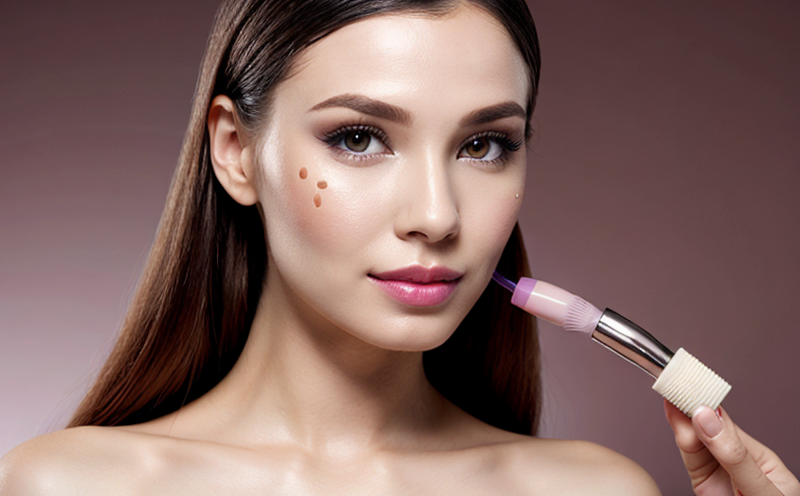In Vitro Safety Evaluation of Anti-Aging Cosmetic Products
As the global population ages and the demand for effective anti-aging solutions continues to grow, ensuring these products are safe for use is paramount. In vitro safety evaluation methods provide a robust and efficient means to assess potential risks associated with cosmetic formulations. This service focuses specifically on evaluating the safety of anti-aging cosmetic products using in vitro techniques that simulate real-world conditions without the need for animal testing.
The process involves several key steps, beginning with the selection of appropriate cell lines and growth media tailored to mimic the skin’s microenvironment. Cells are then exposed to various components of the anti-aging product, including active ingredients like retinoids, peptides, and antioxidants. The primary objective is to monitor cellular responses such as inflammation markers (TNF-alpha), oxidative stress indicators (ROS levels), and DNA damage.
For instance, when testing a formulation containing retinol, we employ advanced imaging techniques like confocal microscopy to visualize changes in epidermal integrity post-treatment. Similarly, for peptides that target collagen synthesis, we measure extracellular matrix protein production using enzyme-linked immunosorbent assays (ELISAs). These methods allow us to assess not only the efficacy but also the potential cytotoxicity of each component.
The use of in vitro models ensures high reproducibility and consistency across tests. Moreover, this approach aligns with increasingly stringent regulatory requirements worldwide, including those set forth by international standards such as ISO 10993-4 for biocompatibility assessments. By leveraging these cutting-edge technologies, our service offers a reliable pathway to ensure the safety of anti-aging cosmetic products while adhering to ethical guidelines.
In summary, this in vitro evaluation provides critical insights into the potential adverse effects of anti-aging cosmetics early in the development process. It enables stakeholders to make informed decisions regarding formulation adjustments or discontinuation if necessary. This not only enhances product quality but also supports broader sustainability goals by reducing reliance on animal testing and minimizing environmental impact.
Why Choose This Test
The choice of in vitro safety evaluation for anti-aging cosmetic products is driven by several compelling reasons:
- Regulatory Compliance: Adhering to international standards like ISO 10993-4 ensures compliance with global regulatory frameworks.
- Ethical Considerations: By eliminating the need for animal testing, this method aligns with ethical principles and consumer expectations.
- Efficiency: In vitro tests are faster and more cost-effective compared to traditional in vivo approaches.
- Data Quality: High reproducibility of results enhances data reliability and confidence levels among researchers and developers.
Furthermore, this service offers a comprehensive understanding of the biological impact of anti-aging ingredients, facilitating better product formulation decisions. The ability to quickly identify problematic compounds allows for rapid iteration, leading to more effective products sooner.
In conclusion, selecting in vitro safety evaluation not only streamlines regulatory pathways but also promotes responsible innovation within the cosmetic industry.
Environmental and Sustainability Contributions
The implementation of in vitro testing methods in anti-aging cosmetic product development contributes significantly to environmental sustainability. By replacing animal testing with cell-based models, this practice eliminates the need for large-scale vivisection, thereby reducing carbon footprints associated with laboratory housing and transportation.
In addition to ethical benefits, in vitro tests consume fewer resources such as water, electricity, and chemicals. The reduced demand for raw materials also helps lower overall production costs, making these products more accessible to consumers worldwide.
Moreover, the use of biodegradable substrates and eco-friendly reagents further enhances the sustainability profile of this method. As awareness about environmental responsibility grows, incorporating such practices into product development processes can significantly improve brand reputation and market acceptance.
The shift towards in vitro testing reflects a broader trend toward more sustainable business practices across industries. By embracing these changes early on, companies position themselves at the forefront of innovation while contributing positively to global sustainability efforts.
Competitive Advantage and Market Impact
Adopting advanced in vitro safety evaluation methods offers significant competitive advantages for manufacturers of anti-aging cosmetic products. Early identification and resolution of safety concerns through rigorous testing ensures higher product quality, which translates directly into customer satisfaction and loyalty.
In a crowded market where brand reputation is crucial, demonstrating commitment to ethical practices and regulatory compliance can set companies apart from competitors. This transparency fosters trust among consumers who value responsible business conduct.
The ability to accelerate new product introductions by streamlining the evaluation process also contributes to faster time-to-market strategies. Faster access to markets translates into increased market share opportunities, especially given the ever-evolving demands of aging populations seeking effective anti-aging solutions.
Furthermore, successful implementation of this service can lead to enhanced innovation cycles, allowing companies to stay ahead of trends and capitalize on emerging technologies in skincare science. This strategic positioning not only strengthens current offerings but also paves the way for future breakthroughs.
In summary, integrating advanced in vitro safety evaluation into anti-aging cosmetic product development equips manufacturers with tools necessary to maintain leadership positions in a competitive landscape while promoting ethical standards and sustainability practices.





